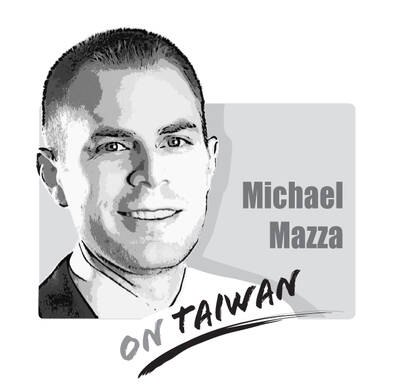The media reported that a Chinese vessel crossed the median line of the Taiwan Strait to dredge sand illegally in waters near Penghu County and capsized. The captain apparently neglected to balance his cargo, while being buffeted by strong winds and big waves.
The eastern side of the Strait, into which the Chinese dredger intruded, is commonly called the “Taiwan Banks” (台灣淺堆), or the Nancian Fishing Ground (南淺漁場) among Penghu fishers.
Chinese vessels frequently enter these waters to illegally dredge sand. The dredging harms the ecology of the waters near Penghu, as well as violating the sovereignty and national security of Taiwan.
The government should pass amendments as soon as possible to safeguard the livelihoods of Taiwanese fishers and maintain national security.
The Taiwan Banks are an important fish spawning ground, but dredging by Chinese vessels has seriously damaged the area’s ecology.
In the past, Chinese fishers breached stipulations in the UN Convention on the Law of the Sea on the mesh size of fishing nets by using three layers of nets to catch fish of all sizes, causing severe overfishing and making it difficult for Taiwanese fishers to earn a living. Often, what fishers could earn from a catch was not enough to cover their fuel costs.
The government must seriously consider these problems and come up with solutions.
A US think tank was quoted by the media as saying that Penghu is key to the safety of both sides of the Strait, which highlights its strategic location.
The first lighthouse in Taiwan was built on Yuwengdao (Fisher Island, 漁翁島) in Penghu’s Siyu Township (西嶼) in 1778, during the reign of the Qing Dynasty’s Qianlong emperor (乾隆), and was rebuilt during the reign of emperor Guangxu (光緒) in 1875.
Next to the lighthouse, Qing Dynasty viceroy Li Hongzhang (李鴻章) built the Eastern Fort (東台古堡) and Western Fort (西台古堡), which are now listed as first-class national historic sites.
After World War II, Yuwengdao became an anchoring area for the US Seventh Fleet and several hydrofoil dual-purpose aircraft.
The Republic of China Army’s 101st Amphibious Reconnaissance Battalion also used to be stationed at the Eastern Fort.
The Penghu archipelago, part of a continental reef shelf, is composed of many islands, which makes it suitable for fish habitats, migration and spawning, but not conducive for navigating boats.
During the autumn and winter, reduced visibility due to strong winds and big waves caused by the northeast monsoon can pose a severe challenge to sailors trying to navigate the area, and frequently results in shipwrecks.
The Executive Yuan should conduct a new survey of the area and update the navigational charts with more detailed information on reefs and islands.
It should also construct additional lighthouses where necessary — that would facilitate civilian navigation, while aiding navy transportation and patrols.
Tsai Kuo-shyan is a director born in Penghu County’s Siyu Township.
Translated by Lin Lee-kai

Could Asia be on the verge of a new wave of nuclear proliferation? A look back at the early history of the North Atlantic Treaty Organization (NATO), which recently celebrated its 75th anniversary, illuminates some reasons for concern in the Indo-Pacific today. US Secretary of Defense Lloyd Austin recently described NATO as “the most powerful and successful alliance in history,” but the organization’s early years were not without challenges. At its inception, the signing of the North Atlantic Treaty marked a sea change in American strategic thinking. The United States had been intent on withdrawing from Europe in the years following
My wife and I spent the week in the interior of Taiwan where Shuyuan spent her childhood. In that town there is a street that functions as an open farmer’s market. Walk along that street, as Shuyuan did yesterday, and it is next to impossible to come home empty-handed. Some mangoes that looked vaguely like others we had seen around here ended up on our table. Shuyuan told how she had bought them from a little old farmer woman from the countryside who said the mangoes were from a very old tree she had on her property. The big surprise
Ursula K. le Guin in The Ones Who Walked Away from Omelas proposed a thought experiment of a utopian city whose existence depended on one child held captive in a dungeon. When taken to extremes, Le Guin suggests, utilitarian logic violates some of our deepest moral intuitions. Even the greatest social goods — peace, harmony and prosperity — are not worth the sacrifice of an innocent person. Former president Chen Shui-bian (陳水扁), since leaving office, has lived an odyssey that has brought him to lows like Le Guin’s dungeon. From late 2008 to 2015 he was imprisoned, much of this
The issue of China’s overcapacity has drawn greater global attention recently, with US Secretary of the Treasury Janet Yellen urging Beijing to address its excess production in key industries during her visit to China last week. Meanwhile in Brussels, European Commission President Ursula von der Leyen last week said that Europe must have a tough talk with China on its perceived overcapacity and unfair trade practices. The remarks by Yellen and Von der Leyen come as China’s economy is undergoing a painful transition. Beijing is trying to steer the world’s second-largest economy out of a COVID-19 slump, the property crisis and